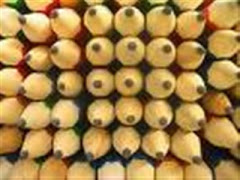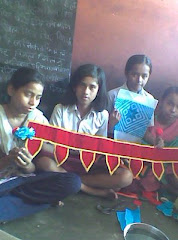Monday 27 April 2009
We save a few rupees, but they rake in crores
A crore of rupees - Rs 1,00,00,000
It is downturn time. People have lost jobs. Many have had to do with a cut in their salaries. The poor always had it bad, but the middle class is feeling the squeeze. Housing loans need to be paid off; school fees too. On top of it the elections have added to the woes. Summer means a rise in the price of vegetables. But the price of staples like rice, atta (wheat flour) and dals (lentils) has risen by about five to ten rupees per kilo. Ditto with sugar. When I protest, my neighbourhood grocer looks at me pityingly and explains, "Madam, I am being forced to charge the high rates. I am getting the goods at a higher price. Don't you know the sugar lobby has financed the political parties to the tune of some crores? In return, they have been assured that they can sell sugar at any price they want.”
More hardship for the common people – India’s middle class who will eventually have to bear the cost of the elections. Our rich netas (leaders) will get elected to another five years of pure unadulterated money making spree.
Meanwhile, I bargain for a few rupees with the vegetable vendor. I check out the price of 10 kg of atta in four shops to see who will give me the best price. I save a few rupees.
The leaders will rake in crores. A study shows how their wealth has grown between two elections. L Rajagopal of the Congress party representing Vijayawada in Andhra Pradesh was worth Rs 9.6 crores in 2004 and now five years later he has declared Rs 299 crores as his assets! An increase of over 30 times!
There are many such candidates. Check out the following articles -
http://timesofindia.indiatimes.com/articleshow/4367826.cms
http://timesofindia.indiatimes.com/India/Fastest-way-to-become-rich-Become-an-MP/articleshow/4484286.cms
It is a good thing that the politicians are being asked to declare their assets and their educational qualifications. Check out the election commission site -
http://eci.nic.in/ElectoralLaws/OrdersNotifications/Order_Assests_Affidavits.pdf
Of course we have no way of ensuring that what the leader has declared is all the assets he or she has. But we need to be told how they made the money and how much they have paid by way of tax. These figures should be available on the election commission website.
While the electorate is expected to pay its taxes, and penalties are stiff for late payment and evasion, our leaders evade them with impunity. In the state of Mizoram, none of the ten top candidates even possess a PAN card! Do we really want leaders like these- who have no regard for the law of the land? And shouldn’t we demand to know how the income tax authorities have proceeded against these worthies?
See how the assets of our political masters rose -
http://www.business-standard.com/india/storypage.php?autono=353302
Check out how the residents of Vadodara are demanding their right to choose not to vote.
http://www.dnaindia.com/report.asp?newsid=1249952
Is it any wonder then, why the middle class is so disenchanted of the politicians that it does not come out to vote. And the pundits on television keep asking why the elections do not enthuse the middle class and why it chooses to treat voting day as a holiday instead of joining the queue to vote a leader. If you do not take part in an election you have no right to grumble, say those working for election reforms. Fair enough! But what if the choice is choosing between a thug and a lesser thug? Then we should rather have the choice to register that none of the candidates meet our expectations and we choose not to vote. Like some people have in some constituencies.
And if in any constituency a certain percentage of voters say that they feel that none of the candidates are worth choosing, then the constituency should come under President’s rule. By having such a law, we would ensure that the political parties pick their candidates with care. For they would not like to see it go under President’s rule. We need such a law, and we need it quick. Otherwise, the fixers and the thugs will continue to occupy the seats of power.
Wednesday 22 April 2009
Where is my leader?
Here I wish to focus on my immediate neighbourhood in the capital city of Delhi and why it is so tough for me to find my leader.
I see corruption and callousness of the powers-that-be towards the common man. I see the power of money. It is used to bend the rule of the land, and in the bargain, the common man or woman is put through needless harassment of an unthinking system.
An example: Many buildings in my neighbourhood stand testimony to norms having been flouted, especially by the builders. Not only do they cover more than the stipulated area, they also rise much higher than what has been laid down.
If you want to buy a house, you will have to be really lucky to get one with a completion certificate; for most come without one. But the estate agent will assure you, “Don’t worry. You will not be harassed. Everything has been taken care of.” This means the pockets of those who matter have been adequately lined with money.
For decades people had encroached upon government land with impunity, added rooms and extensions not permissible by law, and operated commercial outfits from residential premises. Political masters chose to turn a blind eye, extracting money to let the matters rest. Even the poor cobbler on my street gave hafta (a sum of money paid every week) to the cops so that they would not drive him away from the pavement.
One day, the administration woke up. Some people were served demolition notices. Then the bulldozers arrived. I saw two brand new buildings that were being given the finishing touches being targeted. The builder of one building, and the owner of the other had deviated from the guidelines. Why did the municipal corporation pass the plan in the first place? And then why did it wait till the building was ready to take action?
But it had to act. Politicians of various hues had to score points. Delhi had to be made into a world- class city in time for the Commonwealth Games. So action had to be taken, or shown to have been taken. Some portions of the outer walls of the two buildings which faced the main road were knocked down. The way the bulldozer carefully selected where to hit, told a story of money having exchanged hands. The neighbourhood buzz had it that a few lakhs were given to the officers to be ‘considerate’, to inflict damage that could be rectified with the least possible expense.
The buildings stood with the holes for months. As if they were a testimony to an administration that acts. There was much hue and cry in the city. Many business establishments were shut down. Many people lost their jobs. People took out protest matches and went to court. The opposition made a din. Newspapers and television channels faithfully covered the demolitions. And then as happens in this land, things died down, just as suddenly.
The workers returned. Bricks were added to the gaping holes, a coat of plaster and a brush of paint and it looked as if nothing had ever happened. Only some people in the municipal corporation and their political masters got richer by a few lakhs.
The whole drama served no purpose. By the end of it no one was wiser. Who were the corrupt officers, who bended the rules and pocketed the money? We did not get to know. Would they ever be punished? Of course not. For then the corrupt politicians would be exposed. And the politician is a special breed, above the law.
Another example: I went vegetable shopping and parked my car in the same spot I have been parking over the past decade. Only, this time when I returned, my car was missing. A helpful soul announced: “Your car has been towed away!” Nonplussed, I headed for the police station. I was fined – Rs 600 for parking at a no-parking zone.
“There is no such board on the street. And I have been parking there for years,” I told the cop.
“Well, now you can’t park there,” he said.
“Where do I park then?”
“On the opposite side of the road.”
“When did you change the rule?” I ask.
“A week ago.”
“But I have seen no board announcing that,” I pleaded.
“We can’t be putting up boards on every street,” he retorted.
An old man arrived. Panting and puffing, he came looking for his car. Another Rs 600…and on it went. At least five persons paid up in the half an hour I spent there.
Who could I complain to at this arbitrary functioning of the police? Where is my neta?
Oh! Who do I vote for?
Friday 10 April 2009
The essence of India...one nostalgic post

I head for the main door of the building, hoping to run up the steep staircase, like I did as a teenager. A panwala sits on the platform in front of it, like his father had done decades ago. Only the man does not know who I am. His father would greet me with a 'namste beti' (greeting to you daughter) and put a cardamom and some meethi supari (sweetened betel nut) into my open palm. The double panelled door is bolted. A big lock hangs from the latch. In this age of terrorism, you cannot keep open the door of even a bare building. Time changes...but I feverently hope the essence of India would live forever.
Sunday 5 April 2009
extremists frighten us into silence
This was to be a blog on India. But one of my pet themes is human expression and how society seeks to control it. Expression gets curtailed, free speech is banned by a few among us who are loud enough to shout and violent enough to stomp, tear, destroy and even kill. All this as the majority of us just stand and watch, and remain silent.
Increasingly these shouters are getting more vocal, much louder and they frighten us into submission. With threats of violence, and vandalalim and plain murder.
And what is happening? The movie maker shifts base, the artist pulls down his work, the writer is banned. It is happening all over the world and with a frigthening regularity and frequency. Yes, we are becomong a lot less tolerant. We are unable to take criticism. We are unable to debate or frame fitting replies to something we do not like, or hold a contrary view to, in a civilised manner. When someone writes something, and we think it is wrong, why can't the argument be put forth in a civilised manner. Another article or a book, perhaps? Another set of paintings depcting the contrary view? Why do we have to throw stones, burn property and kill?
Last month, a Norwegian Library was forced to pull down posters of "anti-extremist Islamic Art" after vandalism and complaints by a small group of Muslims (three women we are told) who vandalised some works, and the library was forced to pull them down.
The posters were done by Ahmed Mashhouri, a Muslim artist and refugee from Iran. Ahmed and his wife were human rights activists in Iran and knew what people can do in the name of religion as they had experienced at first hand the cruelty of the Muslim fanatics.
The posters were up for only a few hours before the women got at them. This is what I call rowdy censorship and falls in the same category as the one that drove Deepa Mehta away from India for the filming of her film on widows, that drove Bangladeshi author Tasleema to exile first from her home country and for the second time from India, the country where she had sought refuge.
It is what frigthened a Mumbai gallery from exhibiting a painting which depicts nothing more than what our ancient scupltures do . Links to some of the stories are provided below.
The poster from the top is from Ahmed Mashhouri's collection.
In fact, I found the recent video of the public flogging of a girl in Swat valley of Pakistan, which was widely circulated, very very disturbing. The poster in fact, seems a watered down version in comparison of what some fanatics among us do to women in the name of religion.
I wonder if those who protested at the Norwegian library will raise their voice against the public flogging of a teenaged girl in Swat? Will those who bayed for the head of the Danish cartoonist, speak up against the flogging? And demand that those who did it be punished for their very unislamic act. Will the men who flogged her be brought to book?
For more on the posters -
Gateway Pundit: Artist Told to Remove Anti-Islam Display After Muslims Attack Exhibition
http://deathby1000papercuts.com/2009/03/norwegian-library-pulls-exhibit-of-anti-extremist-islamic-art-after-vandalism-and-complaints-by-muslims/
Articles on this blog -
Friday 3 April 2009
What kind of a religion is this?
http://www.guardian.co.uk/world/2009/apr/02/taliban-pakistan-justice-women-flogging
The video of a 17-year-old girl being flogged in the Swat Valley is very shocking. Reminded me of the Muthalik goons in Mangalore. Even they beat up women.
There was national outrage in India. And women came together to demand action against the creeps. Does anyone know what has happened to them? The media these days can only report on the elections. Are Muthalik's men in jail? Or are they out? When will justice be meted out to them?
I was very happy to see condemnation by Pakistanis to the flogging. Here is the link to the way they have reacted - http://www.defence.pk/forums/current-events-social-issues/24378-video-girl-17-flogged-taliban-savages-swat.html. Check out another reaction at http://pakcom.com/is-this-shariah-law/
Will the voices become vocal and strong for the government to reverse its pact with the Taliban powers that be? Have my doubts.
I loved the pink chaddi campaign in India. At least here, the women and men could try and shame the goons. It was action by the public, to show Muthalik and his ilk what we thought of them.
Okay, so the Swat society decided the woman had to be punished for something that is a crime in their eyes. A large group of men stood and just watched. Her brother was among those who participated in flogging her. But what about the man she was with? Is it okay for him to step out of the house with a woman not his wife? Will not the same punishment be meted out to him?
Now, how can one even ask a question like this!
Wednesday 1 April 2009
If you want to be healthy learn to express





These slides were sent to me by a friend who was a budding sportswoman and in the prime of her life met with an accident that left her paralysed.
She is a woman of immense courage and great wisdom. Ten minutes in her company and the statements she makes get you thinking about life. Why are we here? What is our role on Mother Earth? Why was I born?
What I have learnt from her is how to keep your spirits high in the face of immense hardship. And find meaning and happiness in life....
And for that, it is so important that one learns to express...Being able to talk, write, paint your feelings make you healthier. It is true. Try it.

.jpg)




+(2).jpg)

